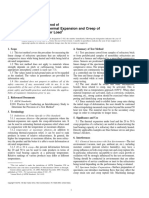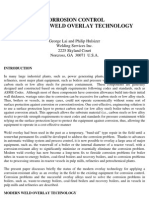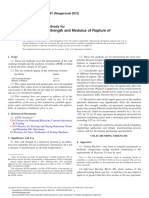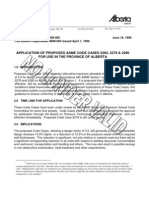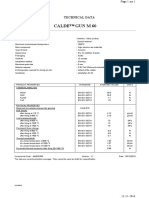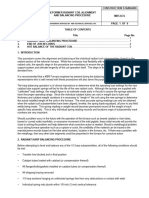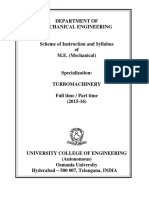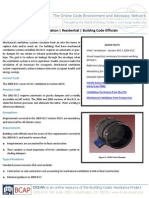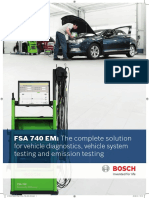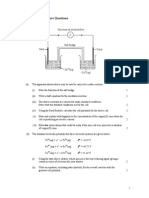Astm C16
Astm C16
Uploaded by
nee2790Copyright:
Available Formats
Astm C16
Astm C16
Uploaded by
nee2790Original Title
Copyright
Available Formats
Share this document
Did you find this document useful?
Is this content inappropriate?
Copyright:
Available Formats
Astm C16
Astm C16
Uploaded by
nee2790Copyright:
Available Formats
Designation: C16 − 03 (Reapproved 2012)
Standard Test Method for
Load Testing Refractory Shapes at High Temperatures1
This standard is issued under the fixed designation C16; the number immediately following the designation indicates the year of original
adoption or, in the case of revision, the year of last revision. A number in parentheses indicates the year of last reapproval. A superscript
epsilon (´) indicates an editorial change since the last revision or reapproval.
1. Scope this test method. The test method is normally run at sufficiently
1.1 This test method covers the determination of the resis- high temperature to allow some liquids to form within the test
tance to deformation or shear of refractory shapes when brick or to cause weakening of the bonding system. The result
subjected to a specified compressive load at a specified is usually a decrease in sample dimension parallel to the
temperature for a specified time. applied load and increase in sample dimensions perpendicular
to the loading direction. Occasionally, shear fracture can occur.
1.2 The values stated in inch-pound units are to be regarded Since the test provides easily measurable changes in
as standard. The values given in parentheses are mathematical dimensions, prescribed limits can be established, and the test
conversions to SI units that are provided for information only method has been long used to determine refractory quality. The
and are not considered standard. test method has often been used in the establishment of written
1.3 This standard does not purport to address all of the specifications between producers and consumers.
safety concerns, if any, associated with its use. It is the 3.2 This test method is not applicable for refractory mate-
responsibility of the user of this standard to establish appro- rials that are unstable in an oxidizing atmosphere unless means
priate safety and health practices and determine the applica- are provided to protect the specimens.
bility of regulatory limitations prior to use.
2. Referenced Documents 4. Apparatus
2.1 ASTM Standards:2 4.1 The apparatus shall consist essentially of a furnace and
C862 Practice for Preparing Refractory Concrete Specimens a loading device. It may be constructed in accordance with Fig.
by Casting 1 or Fig. 2 or their equivalent.4
E220 Test Method for Calibration of Thermocouples By 4.1.1 The furnace shall be so constructed that the tempera-
Comparison Techniques ture is substantially uniform in all parts of the furnace. The
2.2 ASTM Adjuncts: temperature as measured at any point on the surface of the test
Direct-Load Type Furnace (Oil or Gas Fired, or Electrically specimens shall not differ by more than 10°F (5.5°C) during
Fired); Lever-Load Type Furnace3 the holding period of the test or, on test to failure, above
2370°F (1300°C). To accomplish this, it may be necessary to
3. Significance and Use install and adjust baffles within the furnace. A minimum of two
burners shall be used. If difficulty is encountered in following
3.1 The ability of refractory shapes to withstand prescribed
the low-temperature portion of the schedule (particularly for
loads at elevated temperatures is a measure of the high-
silica brick), a dual-burner system is recommended, one to
temperature service potential of the material. By definition,
supply heat for low temperatures and another for the higher
refractory shapes must resist change due to high temperature;
temperatures.
and the ability to withstand deformation or shape change when
subjected to significant loading at elevated temperatures is 4.2 The temperature shall be measured either with
clearly demonstrated when refractory shapes are subjected to calibrated5,6,7 platinum - platinum - rhodium thermocouples,
each encased in a protection tube with the junction not more
1
This test method is under the jurisdiction of ASTM Committee C08 on
Refractories and is the direct responsibility of C08.01 on Strength.
4
Current edition approved Oct. 1, 2012. Published November 2012. Originally Blueprints of detailed drawings of the furnaces shown in Figs. 1 and 2 are
approved in 1917. Last previous edition approved in 2008 as C16 – 03(2008). DOI: available from ASTM International. Request ADJC0016.
5
10.1520/C0016-03R12. Test Method E220 specifies calibration procedures for thermocouples.
2 6
For referenced ASTM standards, visit the ASTM website, www.astm.org, or The National Institutes of Standards and Technology, Gaithersburg, MD 20899,
--`,``,``,`,,,,````,,````,```,-`-`,,`,,`,`,,`---
contact ASTM Customer Service at service@astm.org. For Annual Book of ASTM will, for a fee, furnish calibrations for radiation-type pyrometers and for thermo-
Standards volume information, refer to the standard’s Document Summary page on couples.
7
the ASTM website. All temperatures specified in this test conform to the International Practical
3
Available from ASTM International Headquarters. Order Adjunct No. Temperature Scale of 1968 (IPTS 1968) as described in Metrologia, Vol 5, No. 2,
ADJC0016. Original adjunct produced in 1969 . 1969, pp. 35–44.
Copyright © ASTM International, 100 Barr Harbor Drive, PO Box C700, West Conshohocken, PA 19428-2959. United States
Copyright ASTM International
Provided by IHS under license with ASTM
1Licensee=Shell Global Solutions International B.V. Main/5924979112, User=suruliv
No reproduction or networking permitted without license from IHS Not for Resale, 03/17/2013 00:09:40 MDT
C16 − 03 (2012)
--`,``,``,`,,,,````,,````,```,-`-`,,`,,`,`,,`---
SI Equivalents
in. mm
18 460
24 610
NOTE 1—Dimensions are in inches.
FIG. 1 Direct-Load Type Test Furnace
than 1 in. (25 mm) from the center of the side or edge of each 5.3 The test specimen shall be measured before testing, four
specimen or with a calibrated5,6,7 pyrometer. A recording form observations being made on each dimension (length, width,
of temperature indicator is recommended. If the optical pyrom- and thickness), at the center of the faces to within 60.02 in.
eter is used, observations shall be made by sighting on the face (0.5 mm). The average dimensions shall be recorded, and the
of the specimens and in the same relative positions as those cross section calculated.
specified for the thermocouples.
6. Setting the Test Specimen
5. Test Specimen
6.1 The test specimen, set on end, shall occupy a position in
5.1 The test specimen shall consist of a minimum of two 9 the furnace so that the center line of the applied load coincides
by 41⁄2 by 21⁄2 or 3-in. (228 by 114 by 64 or 76-mm) straight with the vertical axis of the specimen as indicated in Fig. 1 and
refractory brick, or specimens of this size cut from larger Fig. 2 and shall rest on a block of some highly refractory
refractory shapes, utilizing as far as possible existing plane material, neutral to the specimen, having a minimum expansion
surfaces. or contraction (Note 1). There shall be placed between the
5.2 If necessary, the ends of the specimen shall be ground so specimen and the refractory blocks a thin layer of highly
that they are approximately perpendicular to the vertical axis. refractory material such as fused alumina, silica, or chrome
Copyright ASTM International
Provided by IHS under license with ASTM
2Licensee=Shell Global Solutions International B.V. Main/5924979112, User=suruliv
No reproduction or networking permitted without license from IHS Not for Resale, 03/17/2013 00:09:40 MDT
C16 − 03 (2012)
NOTE 1—Dimensions are in inches. See Fig. 1 for SI equivalents.
FIG. 2 Lever-Load Type Test Furnace
ore, that has been ground to pass a No. 20 (850-µm) ASTM 7.2 Heating—The rate of heating shall be in accordance
sieve (equivalent to a 20-mesh Tyler Standard Series). At the with the requirements prescribed in Table 1. The temperature
top of the test specimen a block of similar highly refractory shall not vary more than 620°F (11°C) from the specified
material should be placed, extending through the furnace top to temperature.
receive the load.
7.3 Furnace Atmosphere—Above a temperature of 1470°F
NOTE 1—Recommended designs for the furnace and loading device are (800°C) the furnace atmosphere shall contain a minimum of
shown in Fig. 1 and Fig. 2. Inside dimensions may vary between those
shown on these drawings. The dimensions of the framework will be 0.5 % oxygen with 0 % combustibles. Take the atmosphere
determined by the selection made on inside dimensions, thickness of sample from the furnace chamber proper, preferably as near the
refractory wall etc. The framework for either the direct loading or lever test specimen as possible.
--`,``,``,`,,,,````,,````,```,-`-`,,`,,`,`,,`---
type are shown in sufficient detail so detailed drawings for furnace
construction can easily be made. The use of a flue system with either 7.4 Completion of Test and Report
design is optional. 7.4.1 Include in the report the designation of the specimens
NOTE 2—Gross errors which may more than double the deformation
will result if the specimen is not set perpendicular to the base of the tested (manufacturer, brand, description, etc.). Note, if
support or if the load is applied eccentrically. applicable, specimen preparation procedures, character of the
faces (cut, ground, as-pressed, as-cast, etc.), and pretreatments
7. Procedure (curing, firing, coking, etc.).
7.1 Loading—Calculate the gross load to be applied 7.4.2 When a shear test is completed by failure of the
throughout the test from the average cross section of the specimens, report the temperature of shear. At the expiration of
original specimen as determined in 5.3. Apply a load of 25 psi a test that does not involve shearing of the specimens, allow the
(172 kPa), before heating is started. When testing specimens furnace to cool by radiation to 1830°F (1000°C) or lower
that are likely to fail by shear, make provision so that the before the load is removed and the specimens are examined.
loading mechanism cannot drop more than 1⁄2 in. (13 mm) After cooling the test specimens to room temperature, re-
when failure occurs. measure them for length in accordance with 5.3. Calculate and
Copyright ASTM International
Provided by IHS under license with ASTM
3Licensee=Shell Global Solutions International B.V. Main/5924979112, User=suruliv
No reproduction or networking permitted without license from IHS Not for Resale, 03/17/2013 00:09:40 MDT
C16 − 03 (2012)
TABLE 1 Time-Temperature Schedules for Heating the Test Furnace All temperatures shall be maintained within ±20°F (11°C) during the
heat-up schedule and ±10°F (5.5°C) during the holding period.
Elapsed Time from Schedule 1, Schedule 2, Schedule 3, Schedule 4, Schedule 5, Test Schedule 6, Schedule 7,
Start of Heating 2370°F Hold 2460°F Hold 2640°F Hold Silica Brick, to Failure 2900°F Hold 3000°F Hold
Test to Failure
h min °F °C °F °C °F °C °F °C °F °C °F °C °F °C
1 0 930 500 930 500 1040 560 245 120 1330 720 1330 720 1330 720
15 1105 595 1150 620 1255 680 310 155 1490 810 1490 810 1490 810
30 1265 685 1330 720 1470 800 380 195 1650 900 1650 900 1650 900
45 1420 770 1500 815 1650 900 450 230 1780 970 1780 970 1780 970
2 0 1560 850 1650 900 1815 990 535 280 1910 1045 1910 1045 1910 1045
15 1690 920 1795 980 1960 1070 630 330 2005 1095 2005 1095 2005 1095
30 1815 990 1915 1045 2085 1140 775 415 2100 1150 2100 1150 2100 1150
45 1920 1050 2010 1100 2190 1200 1025 550 2180 1195 2180 1195 2180 1195
3 0 2010 1100 2100 1150 2280 1250 1275 690 2260 1240 2260 1240 2260 1240
15 2095 1145 2185 1195 2355 1290 1525 830 2315 1270 2315 1270 2315 1270
30 2165 1185 2255 1235 2425 1330 1750 955 2370 1300 2370 1300 2370 1300
45 2230 1220 2320 1270 2500 1370 1990 1090 2415 1325 2415 1325 2415 1325
4 0 2280 1250 2370 1300 2550 1400 2200 1205 2460 1350 2460 1350 2460 1350
15 2325 1275 2425 1330 2605 1430 2400 1315 Continue at 180°F 2505 1375 2505 1375
30 2370 1300 2460 1350 2640 1450 2550 1400 (100°C)/h 2550 1400 2550 1400
45 Hold for 90 min Hold for 90 min Hold for 90 min 2660 1460 to failure 2595 1425 2595 1425
5 0 ... ... ... 2700 1480 . . . 2640 1450 2640 1450
15 Continue at 100°F 2685 1475 2685 1475
30 (55°C)/h 2730 1500 2730 1500
45 to failure 2775 1525 2775 1525
6 0 ... ... ... ... ... 2820 1550 2820 1550
15 2865 1575 2865 1575
30 2900 1595 2910 1600
45 Hold for 90 min 2955 1625
7 0 ... ... ... ... ... 3000 1650
15
30 Hold for 90 min
Total time 45 6h 6h 6h 8 h to 3000°F 8 h to 3180°F 8h 81⁄2 h
(1650°C) (1750°C)
TABLE 2 Critical Differences
Number of Critical Difference as Percent
Observations of Grand Average
in Average Within One Between
Laboratory Laboratories
1 79.6 96.5
2 56.3 78.4
4 39.8 67.6
6 32.5 63.6
8 28.1 61.5
10 25.2 60.2
100 8.0 55.2
report the average percent deformation, based on the original and a lot of 70 % Al2O3 brick (N = 24) using Schedule 3 were
length, as the average value of the two specimens. evaluated to develop precision and bias statements.
NOTE 3—It is recommended that a photograph be made of the 8.1.2 Using 95 % confidence limits, the differences and
specimens before and after testing to provide useful information. interactions between laboratories were found to be not signifi-
cant. The interaction sum of squares was pooled with the
--`,``,``,`,,,,````,,````,```,-`-`,,`,,`,`,,`---
8. Precision and Bias residual error to calculate the within-laboratory variance:
8.1 Interlaboratory Test Data: Grand mean = 3.19 % subsidence
8.1.1 Results of a round-robin test between six laboratories Standard deviation within laboratories = 60.915 %
running two replicates each of a lot of super-duty fireclay brick Standard deviation between laboratories = 60.629 %
Copyright ASTM International
Provided by IHS under license with ASTM
4Licensee=Shell Global Solutions International B.V. Main/5924979112, User=suruliv
No reproduction or networking permitted without license from IHS Not for Resale, 03/17/2013 00:09:40 MDT
C16 − 03 (2012)
Coefficient of variation within laboratories = 628.7 % 8.3 Bias—No justifiable statement on bias is possible since
Coefficient of variation between laboratories = 619.7 % the true value of hot compressive load deformation cannot be
8.2 Precision: established.
8.2.1 Critical differences were calculated from the coeffi-
cients of variation to normalize for the variation in means for 9. Keywords
the two brick types (x̄ = 5.43 % subsidence for super-duty brick 9.1 compressive load; deformation resistance; high tem-
and 0.939 % subsidence for 70 % Al2O3 brick). Thus, for the perature; refractory brick; refractory shapes
95 % confidence level and t = 1.96, the critical differences are
as specified in Table 2.
8.2.2 The user is cautioned that other test temperatures, test
schedules, and specimens of different compositions may yield
greater or less precision than given above.
ASTM International takes no position respecting the validity of any patent rights asserted in connection with any item mentioned
in this standard. Users of this standard are expressly advised that determination of the validity of any such patent rights, and the risk
of infringement of such rights, are entirely their own responsibility.
This standard is subject to revision at any time by the responsible technical committee and must be reviewed every five years and
if not revised, either reapproved or withdrawn. Your comments are invited either for revision of this standard or for additional standards
and should be addressed to ASTM International Headquarters. Your comments will receive careful consideration at a meeting of the
responsible technical committee, which you may attend. If you feel that your comments have not received a fair hearing you should
make your views known to the ASTM Committee on Standards, at the address shown below.
This standard is copyrighted by ASTM International, 100 Barr Harbor Drive, PO Box C700, West Conshohocken, PA 19428-2959,
United States. Individual reprints (single or multiple copies) of this standard may be obtained by contacting ASTM at the above
address or at 610-832-9585 (phone), 610-832-9555 (fax), or service@astm.org (e-mail); or through the ASTM website
(www.astm.org). Permission rights to photocopy the standard may also be secured from the ASTM website (www.astm.org/
COPYRIGHT/).
--`,``,``,`,,,,````,,````,```,-`-`,,`,,`,`,,`---
Copyright ASTM International
Provided by IHS under license with ASTM
5Licensee=Shell Global Solutions International B.V. Main/5924979112, User=suruliv
No reproduction or networking permitted without license from IHS Not for Resale, 03/17/2013 00:09:40 MDT
You might also like
- Astm C-832Document7 pagesAstm C-832Magesh KumarNo ratings yet
- C113-14 Standard Test Method For Reheat Change of Refractory Brick PDFDocument3 pagesC113-14 Standard Test Method For Reheat Change of Refractory Brick PDFhoangviet20006100% (1)
- Technical Data Sheet Avikote Av 650 R PDFDocument2 pagesTechnical Data Sheet Avikote Av 650 R PDFCIAKNo ratings yet
- WSI Corrosion Control by Weld Overlay (Boilers)Document11 pagesWSI Corrosion Control by Weld Overlay (Boilers)Claudia Mms100% (1)
- Astm C133 PDFDocument5 pagesAstm C133 PDFgems_gce074325No ratings yet
- 650 150Document10 pages650 150ツ ツNo ratings yet
- Astm C201Document6 pagesAstm C201Cesar Bernal100% (1)
- Distributed Generation PDFDocument293 pagesDistributed Generation PDFpitia100% (1)
- Astm C 704 PDFDocument11 pagesAstm C 704 PDFJeganeswaranNo ratings yet
- Design No. XR736: BYBU - XR736 Fire-Resistance Ratings - ANSI/UL 1709 Design/System/Construction/Assembly Usage DisclaimerDocument2 pagesDesign No. XR736: BYBU - XR736 Fire-Resistance Ratings - ANSI/UL 1709 Design/System/Construction/Assembly Usage DisclaimeredoNo ratings yet
- Astm C704-C704M (2012)Document11 pagesAstm C704-C704M (2012)Shiburaj SomarajanNo ratings yet
- BYBU - XR731 - Fire-Resistance Ratings - ANSI - UL 1709 - UL Product Iq - GCP-AVICOTE Z-156PC PDFDocument5 pagesBYBU - XR731 - Fire-Resistance Ratings - ANSI - UL 1709 - UL Product Iq - GCP-AVICOTE Z-156PC PDFCIAKNo ratings yet
- C583.9186 - Modulus of Rupture of Refractory Materials at Elevated TemperaturesDocument4 pagesC583.9186 - Modulus of Rupture of Refractory Materials at Elevated TemperaturesJulio Cesar de MoraesNo ratings yet
- Kaolite 2200-HS, 2200-HS Gun, 2500-HS, 2500-HS Gun, 2500 EXHS, Super HS GunDocument3 pagesKaolite 2200-HS, 2200-HS Gun, 2500-HS, 2500-HS Gun, 2500 EXHS, Super HS GunvladimirNo ratings yet
- Data Sheet Greencast 94: DescriptionDocument2 pagesData Sheet Greencast 94: Descriptionmani0% (1)
- Pressure Vessel Plates, Alloy Steel, 9 Percent Nickel, Double-Normalized and TemperedDocument3 pagesPressure Vessel Plates, Alloy Steel, 9 Percent Nickel, Double-Normalized and TemperedSofiaJabadanEspulgarNo ratings yet
- Super Austenetic Steels P45 PDFDocument3 pagesSuper Austenetic Steels P45 PDFSyed Mahmud Habibur RahmanNo ratings yet
- API936 Effective Sheet-2020 PDFDocument2 pagesAPI936 Effective Sheet-2020 PDFmallesh100% (1)
- Astm G160 98Document1 pageAstm G160 98farid bajuriNo ratings yet
- Astm C71 PDFDocument5 pagesAstm C71 PDFclaudiaNo ratings yet
- Small Diameter Boiler Tube Butt Weld Acceptance Criteria - Arnold - 20 May 2015 PDFDocument8 pagesSmall Diameter Boiler Tube Butt Weld Acceptance Criteria - Arnold - 20 May 2015 PDFAnaximenes 12No ratings yet
- Mil PRF 4556FDocument12 pagesMil PRF 4556FCarlos Lizarraga FloresNo ratings yet
- Internal Epoxy Coating in Surface CondenserDocument14 pagesInternal Epoxy Coating in Surface CondenserChaudhari SanketNo ratings yet
- ASTM G1 Standard PracticeDocument8 pagesASTM G1 Standard PracticeHeri SusantoNo ratings yet
- Specification For Seamless Medium-Carbon Steel Boiler and Superheater TubesDocument4 pagesSpecification For Seamless Medium-Carbon Steel Boiler and Superheater TubesMauricio Esteban Fernandez RamirezNo ratings yet
- P # NumberDocument4 pagesP # NumberManzar KhanNo ratings yet
- Cladding (Metalworking) : Roll BondingDocument4 pagesCladding (Metalworking) : Roll Bondingcal2_uniNo ratings yet
- Rescocast 17EC PDSDocument1 pageRescocast 17EC PDSIfrahim Awan100% (1)
- Astmc133 Ensayo de Comprecion y Modulo de Ruptura en RefractariosDocument6 pagesAstmc133 Ensayo de Comprecion y Modulo de Ruptura en RefractariosSebastian CollazosNo ratings yet
- Tutorial For The Steel Ladle SimulationDocument5 pagesTutorial For The Steel Ladle SimulationJavier TrujillanoNo ratings yet
- Mat Spec, Astm A 694 F65 Low Alloy Steel Forgings: SubseaDocument14 pagesMat Spec, Astm A 694 F65 Low Alloy Steel Forgings: SubseaJones Pereira Neto100% (1)
- Astm C133Document6 pagesAstm C133Teddy HariyantoNo ratings yet
- SAIC N 2019 ReviewVerifyApplicatorPre QualRecord EL RevDocument2 pagesSAIC N 2019 ReviewVerifyApplicatorPre QualRecord EL RevAnonymous S9qBDVkyNo ratings yet
- Case 2278 ASMEDocument6 pagesCase 2278 ASMEPerrita LolaNo ratings yet
- Electrochemistry of CorrosionDocument19 pagesElectrochemistry of CorrosionElambarithi KalyanakumarNo ratings yet
- Arcelormittal APIDocument4 pagesArcelormittal APIBaskara Surya WidagdoNo ratings yet
- Creep & SpheroidizationDocument10 pagesCreep & Spheroidizationabet_singkong8930No ratings yet
- HWI Ramming PlasticsDocument23 pagesHWI Ramming PlasticsMuhammad victoryan nadezul100% (1)
- Brochure API 653 (150129)Document4 pagesBrochure API 653 (150129)junaediNo ratings yet
- Corrosion Rate Investigation Due To Stray CurrentDocument69 pagesCorrosion Rate Investigation Due To Stray CurrentN'FNo ratings yet
- Compare ASTM A216 Grade WCB To ASTM A216 Grade WCCDocument3 pagesCompare ASTM A216 Grade WCB To ASTM A216 Grade WCCRachel BaileyNo ratings yet
- ASTM A537 Class 1 Carbon Steel Plates Are Engineered To Be Used in Pressure Vessel ApplicationsDocument7 pagesASTM A537 Class 1 Carbon Steel Plates Are Engineered To Be Used in Pressure Vessel Applicationsvalli rajuNo ratings yet
- ITP RefractoryDocument1 pageITP RefractoryADOFSLNo ratings yet
- C71 12 PDFDocument6 pagesC71 12 PDFAbdiz Engineering INCNo ratings yet
- Corrosion and Runoff Behavior of Carbon Steel in Simulated Acid RainDocument3 pagesCorrosion and Runoff Behavior of Carbon Steel in Simulated Acid RainIvan GutierrezNo ratings yet
- Controlling Flow Accelerated Corrosion PDFDocument36 pagesControlling Flow Accelerated Corrosion PDFzerocool86No ratings yet
- Tack-Free Time of Elastomeric Sealants: Standard Test Method ForDocument3 pagesTack-Free Time of Elastomeric Sealants: Standard Test Method Formarjan banooNo ratings yet
- Experience With Maintaining A 40 Year Old Reformer: Ajay Joshi & Stan HeaneyDocument14 pagesExperience With Maintaining A 40 Year Old Reformer: Ajay Joshi & Stan Heaneyvaratharajan g rNo ratings yet
- Cold Crushing Strength and Modulus of Rupture of RefractoriesDocument6 pagesCold Crushing Strength and Modulus of Rupture of RefractoriesManivasagan VasuNo ratings yet
- Calde™ Gun M 60Document1 pageCalde™ Gun M 60Yoo Kyungsik100% (1)
- Reformer Radiant Coil Alignment and Balancing ProcedureDocument8 pagesReformer Radiant Coil Alignment and Balancing ProcedureAleem Qureshi100% (1)
- ASTMC16Document5 pagesASTMC16eng.usmanali2012No ratings yet
- Load Testing Refractory Brick at High Temperatures: Standard Test Method ForDocument5 pagesLoad Testing Refractory Brick at High Temperatures: Standard Test Method Forvuqar0979No ratings yet
- C583Document4 pagesC583Muhammad IkramullahNo ratings yet
- Volatile Matter (Including Water) of Vinyl Chloride Resins: Standard Test Method ForDocument2 pagesVolatile Matter (Including Water) of Vinyl Chloride Resins: Standard Test Method ForDeepak AryaNo ratings yet
- Quantitatively Measuring The Effect of Thermal Shock and Thermal Cycling On RefractoriesDocument3 pagesQuantitatively Measuring The Effect of Thermal Shock and Thermal Cycling On RefractoriesDmitry_ucpNo ratings yet
- C832 - Refractoriness Under LoadDocument7 pagesC832 - Refractoriness Under LoadMagesh KumarNo ratings yet
- Pier Test For Refractory MortarsDocument2 pagesPier Test For Refractory MortarsMeethaq AbedNo ratings yet
- API 936 - C113-14-STM For Reheat ChangeDocument3 pagesAPI 936 - C113-14-STM For Reheat ChangeSureshMasilamaniNo ratings yet
- Astm C 356-87Document3 pagesAstm C 356-87Manivasagan VasuNo ratings yet
- D4123 Resilient ModulusDocument4 pagesD4123 Resilient ModulusNurul RizalNo ratings yet
- Turbo Machinery PDFDocument29 pagesTurbo Machinery PDFanon_89945515250% (2)
- DRRR Official Research Paper Fire HazardDocument13 pagesDRRR Official Research Paper Fire HazardMarielle San Pedro0% (1)
- RescoDocument2 pagesRescocanakyuzNo ratings yet
- Lincoln Welder IM10392Document92 pagesLincoln Welder IM10392ipaqiNo ratings yet
- Midos: Type MCND 04 Negative Sequence Overcurrent RelayDocument6 pagesMidos: Type MCND 04 Negative Sequence Overcurrent RelayLuis LizanaNo ratings yet
- 7.1 - Modular Substation Catalogue PDFDocument44 pages7.1 - Modular Substation Catalogue PDFNguyen Ngoc Canh100% (1)
- Nitincalculation Spray Dryer & HagDocument5 pagesNitincalculation Spray Dryer & HagNITIN P SHAH100% (3)
- Switching Overvoltages in Wind FarmsDocument13 pagesSwitching Overvoltages in Wind FarmsMarko IstenicNo ratings yet
- KOTO Pro Dart Scorer InstructionDocument16 pagesKOTO Pro Dart Scorer InstructionKat AntsipavaNo ratings yet
- HVAC Ventilation Residential Building Code OfficialsDocument1 pageHVAC Ventilation Residential Building Code Officialsbcap-oceanNo ratings yet
- Propac: Flushing Procedure For Hydraulic Piping, Tubing & HoseDocument4 pagesPropac: Flushing Procedure For Hydraulic Piping, Tubing & HoseClaudio Hernández PobleteNo ratings yet
- مراجعة نهائية - شمس وقمر - ثانوية عامة 2023docx-1Document108 pagesمراجعة نهائية - شمس وقمر - ثانوية عامة 2023docx-1waledNo ratings yet
- Example Cooling LoadDocument24 pagesExample Cooling LoadmuneebulqayyumNo ratings yet
- SOM Question Bank For RevisionDocument11 pagesSOM Question Bank For RevisiongoldencometNo ratings yet
- Acoustic Emission PDFDocument17 pagesAcoustic Emission PDFAMIGO100% (1)
- Biochemistry Chapter 3Document5 pagesBiochemistry Chapter 3brownhazelNo ratings yet
- Unit 6 ADocument3 pagesUnit 6 AKrzysztofSasyków71% (7)
- ZPEC Stimulation DepartmentDocument12 pagesZPEC Stimulation DepartmentmustafacmitNo ratings yet
- HacDocument158 pagesHacCarlos BraiaNo ratings yet
- Bosch FSA740 Engine AnalyserDocument2 pagesBosch FSA740 Engine AnalyserElvis Flores FloresNo ratings yet
- Ayra Flash 1500d ManualDocument9 pagesAyra Flash 1500d ManualPelle SchillingNo ratings yet
- SI1154R FAA Approved Starters AlternatorsDocument10 pagesSI1154R FAA Approved Starters AlternatorsCTN2010No ratings yet
- Unit 7: Living Things and Air: Science (S1 - 3)Document12 pagesUnit 7: Living Things and Air: Science (S1 - 3)xenaNo ratings yet
- NL02!17!0464 Control PhilosophyDocument56 pagesNL02!17!0464 Control PhilosophynemochuNo ratings yet
- Redox Review - IB-Short QuestionsDocument8 pagesRedox Review - IB-Short QuestionsStephanie LeeNo ratings yet
- KD 225-315-350-400-440Document74 pagesKD 225-315-350-400-440Giusy E GerryNo ratings yet
- Science - Facts at Your Fingertips PDFDocument158 pagesScience - Facts at Your Fingertips PDFTushar Patel100% (7)
- Chemical Reactions Under High Pressure: Nobel Lecture, May 21, 1932Document33 pagesChemical Reactions Under High Pressure: Nobel Lecture, May 21, 1932Niko KojaNo ratings yet
- The Particulate Nature of MatterDocument4 pagesThe Particulate Nature of MatterLeni Widiarti LenwidNo ratings yet
